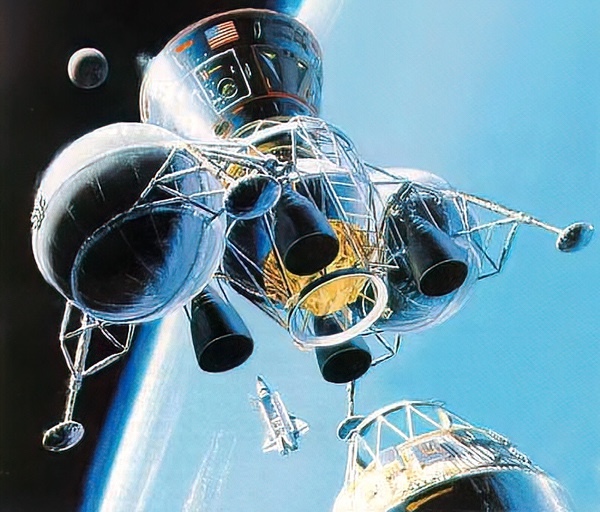 In January 1993, General Dynamics unveiled its Early Lunar Access proposal for returning Americans to the Moon. The company hoped that a new presidential administration would embrace its cheaper method of returning humans to the Moon using existing launch vehicles. But the Clinton administration was already skeptical of NASA's space station program and wary of new civil space expenditures. General Dynamics' study demonstrated that it was difficult to repeat Apollo without much larger launch vehicles. (credit: General Dynamics) |
Moon denied: the 1993 Early Lunar Access proposal
by Dwayne A. Day
Monday, January 9, 2023
Getting to the Moon is hard.
It has been more than half a century since the last humans walked on the lunar surface, or even ventured beyond low Earth orbit. Since that time there have been many proposals to do it again. In January 1993—30 years ago this week—there was a proposal known as Early Lunar Access, and it was an attempt to demonstrate that the Moon could be reached faster, and at less cost, than other proposals during that time period. Although it has become a cliché to claim that the politics of a Moon mission are the tough part and the technology is easy, what Early Lunar Access demonstrated was that many of the technology choices were themselves difficult—there was no such thing as easy lunar access.
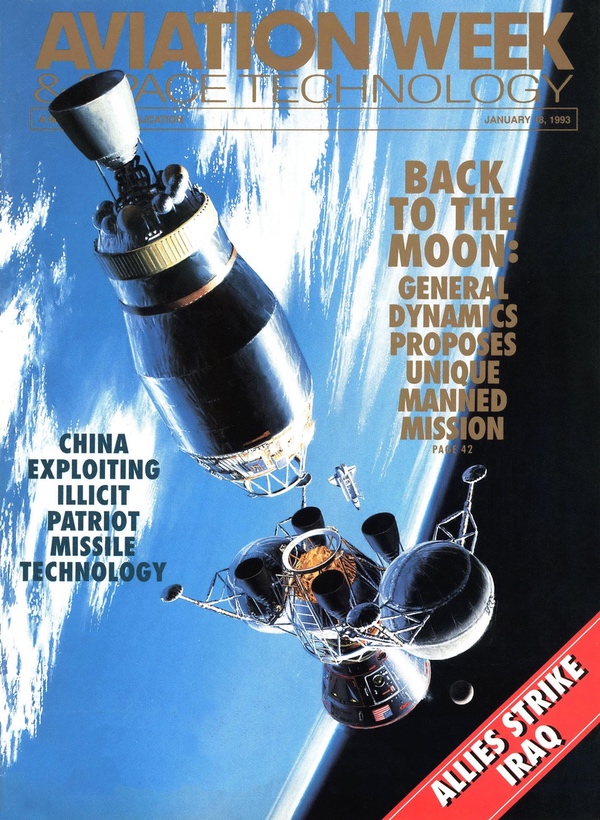 Thirty years ago this week, Aviation Week and Space Technology subscribers received this issue with a cover story about General Dynamics' Early Lunar Access proposal. Soon after, any discussions about returning humans to the Moon stopped for the rest of the decade. |
A stumbling start
In summer 1989, President George H.W. Bush unveiled the Space Exploration Initiative that called for returning Americans to the Moon. NASA’s initial response to the initiative was an expansive report known as the “90-Day Study” that proposed a broad approach including a lunar base, but did not explain the first actions the United States should undertake toward returning to the Moon. The 90-Day Study essentially skipped past the first steps to embrace a bigger vision, which of course included a big price tag, making the entire proposal politically vulnerable. Within days of Bush unveiling his initiative, Congress cut NASA’s budget, indicating it would be a difficult slog to find political support for a return to the Moon. Internal battles in the administration between the National Space Council and NASA leadership did not help, but both the House and the Senate were held by Democrats unwilling to give Bush much support for a new space effort.
| ELA was pitched as an effort to use existing launch vehicles—the Space Shuttle, Titan IV, and perhaps Europe’s Ariane 5—to lower costs. The spacecraft would have been new, but it, too, was based upon existing technology and, the company claimed, some existing hardware. |
By 1992, NASA scaled back to address the initial steps for lunar return in a series of workshops and studies known as the First Lunar Outpost. FLO would have required new spacecraft and a new, large rocket, and although it did not use unproven technology, it required new hardware and infrastructure. (See “Aiming for the Moon, crashing on Earth: The rise and fall of the 1989 Space Exploration Initiative (part 2),” The Space Review, October 31, 2022.) FLO was studied in the summer of 1992, but by this time there was clearly no congressional support for Bush’s initiative. NASA turned its attention to studying a human mission to Mars, with the plan of revisiting the FLO concept and architecture to see how it could be extended to human exploration of the Red Planet. By November, Bush had lost the election, and a new administration would soon enter the White House.
In January 1993, General Dynamics unveiled the Early Lunar Access (ELA) study with a cover story in Aviation Week & Space Technology. The company’s hope was that the Clinton administration might want a proposal for a lower-cost lunar mission. In early May, company officials further discussed the proposal at a one-day symposium on low-cost lunar missions in Washington, DC. (See “Early Lunar Access: An Affordable Approach for Human Return to the Moon” by Paul Bialla, in Low-Cost Lunar Access, AIAA, May 7, AIAA 1993 p.65, and Jeffrey M. Lenorovitz, “GD Goal: Lower-Cost Manned Lunar Missions,” Aviation Week & Space Technology January 18, 1993 p.42.)
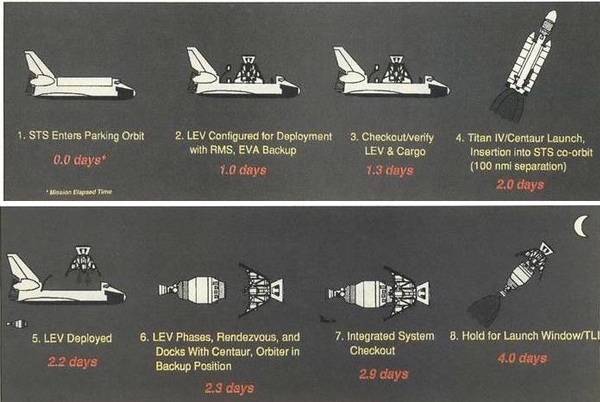 The ELA mission architecture assumed two robotic landings on the Moon before the first human landing followed, perhaps a year or more after the first landing. Because the lunar launch windows were short, NASA would have to quickly launch, assemble, and check out the Lunar Excursion Vehicle before launching the Titan IV with the Centaur and conducting rendezvous and docking prior to sending the spacecraft to the Moon. Doing all of this before the trajectory window closed would have been difficult. The mission design demonstrated that lunar missions using existing launch vehicles were complicated and risky. (credit: General Dynamics) |
Building blocks to the Moon
According to Paul Bialla, General Dynamics’ manager of civil space programs, the lunar program was intended to be bold. “It seems that NASA programs today are oriented toward doing good research and science, but without much excitement and charm. If we want to recapture the imagination of the public and gain support for the space program, we need something with public appeal—not just business as usual,” Bialla told Aviation Week’s Jeffrey Lenorovitz.
ELA was pitched as an effort to use existing launch vehicles—the Space Shuttle, Titan IV, and perhaps Europe’s Ariane 5—to lower costs. The spacecraft would have been new, but it, too, was based upon existing technology and, the company claimed, some existing hardware. The basic assumptions for ELA were to: maximize the use of existing systems and subsystems or their derivatives, achieve a first piloted lunar mission by 2000, provide the capability for crew stay times for up to three weeks on the Moon, provide a shirtsleeve environment for Intra-Vehicular Activity functions (telerobotic lunar rovers), and emplace permanent facilities that can support expansion to larger base operations.
| As usual, the devil was in the details, and anybody who was initially excited that somebody had found a lower cost and faster method for returning humans to the Moon was soon to lose their enthusiasm. |
Each ELA mission would require at least two launches. The Lunar Excursion Vehicle (LEV) would be launched inside a shuttle payload bay and assembled in orbit using the shuttle’s robotic arm. The LEV crew capsule would be similar in shape to the Apollo spacecraft, although smaller. It would be attached to the Lunar Transfer Vehicle, featuring an advanced high performance four-engine liquid oxygen/hydrogen propulsion system that throttles to enable soft landings on the Moon. The engines would be based on the RS-44 or similar rocket engines. It could achieve redundancy via the capability to shut down a diametrically opposed pair in the event of an engine failure.
Two days after the shuttle had launched and the LEV had been assembled and checked out, a Titan IV would launch with a wide-body Centaur upper stage as its payload, putting it into a co-orbit with the shuttle. The LEV would be deployed and rendezvous and dock with the Centaur. The integrated system would be checked out, then launch to the Moon four days after the initial shuttle launch. The Lunar Exploration Vehicle would fly directly to the Moon, without entering a lunar parking orbit or leaving an astronaut in a Command Service Module above the Moon, like Apollo. This approach was similar to the First Lunar Outpost concept, which also did not put a spacecraft in lunar orbit but landed the entire piloted spacecraft, including the ascent vehicle and Earth reentry vehicle, on the lunar surface.
The initial plan was for a robotic LEV to perform the first mission, which Bialla described as “primarily science-oriented.” It would land approximately 9.7 metric tons of scientific and support hardware on the Moon. The equipment could include a geophysical station, telerobotic rover, optical telescope, and solar arrays. It could also include an airlock for a future habitation module. A second mission would also be robotically controlled and carry a habitation module as well as support systems such as a fuel cell power system and environmental control equipment. The habitation module could be built by Italy’s Alenia Spazio, which already had experience with Spacelab carried in the shuttle bay. One option was using a modified version of a logistics module planned for Space Station Freedom.
As usual, the devil was in the details, and anybody who was initially excited that somebody had found a lower cost and faster method for returning humans to the Moon was soon to lose their enthusiasm.
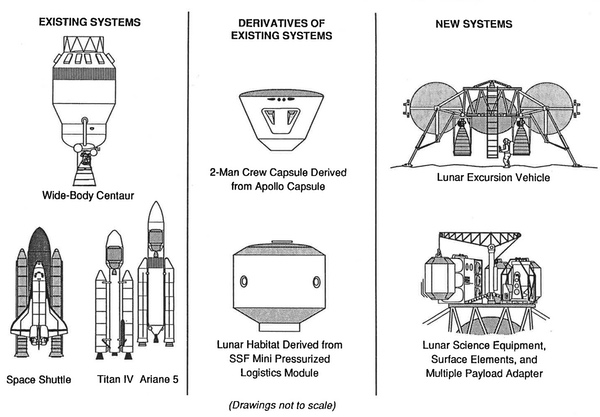 The overall mission would have involved six launches: three Titan IV rockets and three shuttle launches. The first and second missions would have been robotic and landed science instruments and a habitat module on the Moon, using a common lander. The third mission would have carried two astronauts in a small spacecraft known as the Lunar Excursion Vehicle, and they would have rendezvoused and docked with a Centaur propulsion stage to send them to the Moon. The entire LEV would have lifted off the surface of the Moon and brought the astronauts back to Earth in a descent capsule. (credit: General Dynamics) |
Setting goals
In terms of lunar science, ELA’s goals were to characterize geology and physical properties and establish an early astronomy outpost. An engineering goal was to demonstrate a lunar oxygen processing pilot plant. Because NASA had already publicly discussed FLO, General Dynamics tread carefully, pitching ELA as a precursor to FLO, not necessarily a replacement. ELA could land humans on the Moon a few years before FLO, using existing rockets. The pitch was that FLO could follow, adding capability, like extended stay times on the lunar surface.
ELA was intended to demonstrate new technologies and capabilities:
Human Life Support Technologies:
- Assess effectiveness of EMU lunar spacesuits
- Evaluate crew capabilities for moderate (14- to 21-day) stay times
- Determine crew effectiveness during lunar night
Support of NASA’s First Lunar Outpost:
- Survey and map potential landing sites
- Deploy navigation aids and communication links
- Determine effectiveness of telerobotic rovers
- Test materials and equipment exposed to long duration lunar environment
- Deploy critical supplies and equipment
After President Bush announced the Space Exploration Initiative, one of the ongoing internal debates within NASA and the National Space Council was the degree to which new technology could lower costs. There were no new technologies that could be implemented quickly and without substantial up-front investment. Oxygen generation on the lunar surface was one potentially useful technology. But it would not make an initial lunar landing possible, and even if it was successfully demonstrated, it would require substantial infrastructure to become useful. ELA took the complete opposite approach, attempting to use as much existing technology and hardware as possible, but avoiding FLO’s requirement for a new large launch vehicle. But it quickly demonstrated that there were no shortcuts to returning to the Moon.
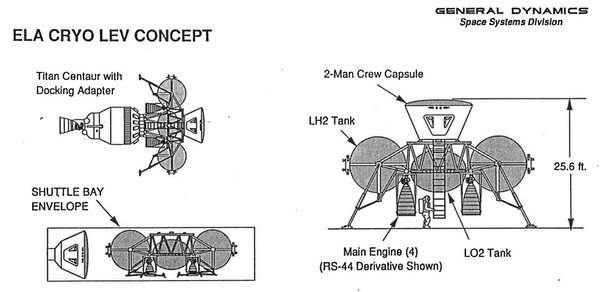 The Lunar Excursion Vehicle would have been carried into low Earth orbit inside a space shuttle payload bay and assembled and checked out over two days. The use of cryogenic propellants in the payload bay, and the requirement for fast on-orbit assembly (assuming no problems) were questionable assumptions. (credit: General Dynamics) |
Devilish details
Although it was supposed to be cheaper than NASA’s First Lunar Outpost—which one independent cost estimate claimed would cost $25 billion, with approximately half of that cost being a new launch vehicle larger than the Saturn V—the ELA design was not simple, requiring six launches, three on-orbit assembly operations, and three vehicle rendezvous and dockings. Missing from General Dynamics’ proposal were many details, like how the astronauts would get from the shuttle to the LEV capsule. Presumably this would require an EVA using the same spacesuits they would later use on the Moon.
| Because NASA had already publicly discussed FLO, General Dynamics tread carefully, pitching ELA as a precursor to FLO, not necessarily a replacement. |
The Centaur stage would not be the existing two-engine variant, but a single-engine version that would use a significantly upgraded RL10 engine like that already in use. Existing RL10s had 15,000 pounds-force (67,000 newtons) of thrust and the new version would have 35,000 pounds-force (155,000 newtons) of thrust.
The plan unveiled by General Dynamics in January 1993 had some dubious assumptions. One was that the vehicle would carry cryogenic propellants in the shuttle payload bay, something NASA had ruled out after the Challenger accident seven years earlier. Another issue was that the vehicle mass exceeded the safe shuttle abort landing weight, meaning that it would have to dump hydrogen and oxygen overboard during an abort, requiring modifications to the shuttle orbiter.
But General Dynamics acknowledged other troubling aspects of the proposal a few months after unveiling the concept in Aviation Week. During the May 1993 low-cost lunar access symposium in Washington, DC, the company stated that the spacecraft, including the Centaur transfer stage, were too big for the existing launch vehicles. The payloads intended for the shuttle exceeded shuttle’s capabilities and required upgrades to carry 25,720-kilogram payloads to a 300-kilometer orbit. This would necessitate either a lightweight external tank or advanced solid rocket motors. NASA eventually adopted the new tank, but the improved booster rockets were canceled. The expendable launch vehicles would have also required upgrades, although details were scant.
The proposed schedule for ELA was aggressive, with a start in 1994, hardware development starting in 1995, and a robotic landing in 1999. This would be followed six months later by the second robotic mission carrying the habitat, and then six months after that the piloted mission would carry two astronauts to the Moon in 2000. General Dynamics estimated that the cost would be $13 billion over seven years—about half the cost of FLO—but could be as low as $10 billion using “modern management” techniques. European participation could bring the cost for the United States down to $6–9 billion, the company claimed. The marginal cost of continuing the program after the first crewed mission would be $2 billion per mission. A fourth expedition could land additional equipment, supplies and spares for an additional two to three piloted missions to the same landing site.
Moon denied
When General Dynamics began working on the ELA proposal in 1992, the Space Exploration Initiative was politically dead. Congress had even zeroed out small lunar precursor missions from NASA’s budget. Although the November election offered some possibility for political change, the election of Bill Clinton soon made the prospects for future space programs even bleaker. The major NASA human spaceflight project at the time was the space station, and the Clinton Administration was skeptical of the station’s cost and value. By spring 1993, the space station was in political jeopardy. Even if it had been technically feasible, General Dynamics’ Early Lunar Access proposal never had a chance.
Discussions of sending humans beyond low Earth orbit faded in 1993, and throughout the rest of the 1990s there was little discussion of the subject in NASA or other government circles. It wasn’t until the early 2000s that the subject would again receive attention within the government. But even now, thirty years later, we’re still waiting for humans to return to the Moon.
The ELA overview presentation can be found here.
Mass Summary for Early Lunar Access Lunar Exploration Vehicle
| CREW CAPSULE | 3,688 kg |
| - Dry weight | 3,071 kg |
| - Fluids | 141 kg |
| - Crew + Supplies | 476 kg |
| LEV | 20,140 kg |
| - Dry mass | 2,649 kg |
| - Fluids | 780 kg |
| - Main propellant | 16,611 kg |
| PAYLOAD ADAPTER | 6,000 kg |
| TOTAL SHUTTLE PAYLOAD | 25,723 kg |
No comments:
Post a Comment